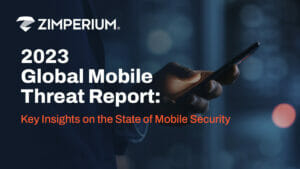
Pharming is a cyber attack method where attackers redirect a website’s traffic to a fraudulent website without the user’s knowledge or consent. Pharming attacks are often achieved by exploiting vulnerabilities in the DNS (Domain Name System) or hijacking the user’s browser. For a mobile app developer, especially in large enterprises like e-commerce companies or retail banks, understanding pharming is crucial due to the sensitive nature of the transactions and data involved.
Definition and Mechanism of Pharming
Pharming, a compound of “phishing” and “farming,” is a cyberattack method that redirects users from legitimate websites to fraudulent ones without their knowledge. This technique is particularly nefarious because it can bypass traditional user vigilance against phishing and directly manipulates the Domain Name System (DNS) or the host files on a device.
- DNS-Based Pharming: This approach involves corrupting the DNS server, a critical component of the internet infrastructure that translates human-readable domain names into IP addresses. In a DNS-based pharming attack, the attacker manipulates the DNS server to return an incorrect IP address for a website, leading users to a fraudulent site. This manipulation can be achieved through DNS cache poisoning, where the attacker exploits vulnerabilities in the DNS server to insert false address records.
- Local Pharming: This method involves altering the host files on an individual’s device. Malware or malicious applications modify the host file, which the operating system uses to map domain names to IP addresses to redirect users to fake websites.
Both methods aim to steal sensitive information, such as login credentials, financial data, or personal identity information, by mimicking the appearance and functionality of legitimate websites.
Importance of Pharming for Enterprise Mobile Applications and Device Security
Understanding pharming is crucial for protecting enterprise mobile applications and device security for several reasons:
- Data Breach and Financial Loss: Enterprise applications often handle sensitive business data, customer information, and financial transactions. A successful pharming attack could lead to significant data breaches, financial losses, and legal ramifications if customer data is compromised.
- Erosion of Trust: Customer trust is a cornerstone for businesses, particularly in banking or e-commerce. Pharming attacks leading to personal data theft can damage a company’s reputation.
- Compliance and Regulatory Requirements: Enterprises are often subject to stringent regulatory requirements regarding data protection and privacy (e.g., GDPR, HIPAA). Pharming attacks directly threaten compliance, potentially leading to heavy fines and legal consequences.
- Network Security: Pharming can affect not just individual users but entire networks. If a mobile device connected to a corporate network is compromised, it can serve as a conduit for broader network attacks.
- Brand Reputation: Pharming attacks can damage the enterprise’s reputation, causing a loss of customer trust and revenue.
An in-depth understanding of pharming is essential in the context of enterprise mobile applications and mobile device security. It allows developers and IT professionals to implement robust security measures, design applications with security in mind, and adopt proactive strategies to protect sensitive data, maintain user trust, and ensure compliance with regulatory standards.
Best Practices for Mitigation and Prevention of Pharming in Mobile Application and Device Security
Pharming, a sophisticated cyber threat, targets the integrity of DNS systems to redirect users unknowingly to fraudulent websites, posing significant risks to mobile applications and devices. Given the rise in mobile internet usage and the critical nature of mobile applications in various sectors, the mitigation and prevention of pharming attacks are paramount. This discussion delves into the technical best practices for combating pharming, tailored specifically for mobile app and device security.
Secure DNS Practices
- DNSSEC Implementation: DNSSEC (Domain Name System Security Extensions) is crucial for securing DNS lookups. It adds a layer of cryptographic authentication to DNS responses, ensuring the integrity and authenticity of the response. Mobile app developers should ensure their domain names are DNSSEC-enabled and encourage or require using DNSSEC-compliant DNS resolvers within their applications.
- Regular DNS Audits: Conduct frequent audits of DNS records to detect unauthorized changes or signs of tampering. This proactive approach helps in early detection and prevention of pharming attacks.
SSL/TLS Certificates
- Enforcing HTTPS: Implement SSL/TLS certificates to ensure all data transmitted between the mobile app and the server is encrypted. This practice is particularly vital for apps handling sensitive data. Using Extended Validation (EV) SSL certificates can provide an additional layer of trust by verifying the legal entity controlling the site.
- Certificate Pinning: Mobile apps should implement certificate pinning, a process where the app is programmed to reject all SSL certificates except the specific, trusted certificate. Pinning prevents attackers from using forged certificates to intercept secure traffic.
Educating Users
- Security Awareness: Users should be educated about the signs of a pharming attack, such as unexpected website behavior or certificate errors. Mobile apps can incorporate alert mechanisms to guide users in verifying the authenticity of websites.
- Safe Browsing Habits: Encourage users to manually type URLs and be cautious of links received via email or messages, a common method for executing pharming attacks.
Robust Malware Protection
- Integrating Anti-Pharming Measures: Integrate anti-malware and anti-phishing features within the app and include regularly updating the app to address new security threats and vulnerabilities.
- Device Security Recommendations: Advise users to install reputable anti-virus and anti-malware software on their mobile devices and to keep their operating systems and apps updated.
Monitoring and Response Plan
- Traffic Analysis: Implement tools to monitor and analyze network traffic for signs of DNS tampering or redirection. Anomalies in DNS requests or responses could indicate a pharming attack.
- Incident Response: Develop a robust incident response plan that includes procedures for identifying, containing, and mitigating pharming attacks, as well as notifying affected users.
Implementing HSTS (HTTP Strict Transport Security)
- HSTS Policy: Enforce HSTS policy in the app’s backend. HSTS instructs browsers to interact with the server only using a secure HTTPS connection, reducing the risk of users being redirected to a fraudulent site.
Mobile Device Management (MDM) and Endpoint Security
- MDM Solutions: For enterprise applications, deploying MDM solutions can enforce security policies on employee devices, such as mandatory encryption and secure DNS settings, to reduce the risk of pharming attacks.
- Endpoint Protection: Implement endpoint security solutions that include DNS filtering and threat intelligence to prevent access to known malicious sites.
Zero Trust Security Models
- Zero Trust Architecture: Adopt a zero trust approach where every request, regardless of origin, is fully authenticated and authorized. This approach reduces the reliance on the integrity of the DNS system and minimizes the impact of pharming attacks.
Blockchain for DNS Security
- Blockchain Innovations: Explore blockchain-based DNS solutions. These decentralized systems can offer enhanced security against DNS tampering due to their inherent resistance to modification and distributed nature.
The mitigation and prevention of pharming attacks are multifaceted, requiring a combination of technical solutions, user education, and proactive monitoring. Implementing secure DNS practices, using SSL/TLS certificates effectively, educating users, incorporating robust malware protection, and establishing comprehensive monitoring and incident response strategies are crucial. Furthermore, embracing emerging technologies like blockchain for DNS security and adopting zero trust models can offer additional layers of protection. For mobile app developers and organizations, these practices are not just about safeguarding data; they are fundamental to maintaining user trust, regulatory compliance, and the overall security posture of the mobile ecosystem.
Emerging Trends and Considerations in Pharming
Pharming has evolved significantly since its inception, adapting to new technologies and security measures. Understanding these emerging trends is crucial for protecting enterprise mobile applications and mobile device security. Here are key developments in the realm of pharming and their implications:
- Sophistication in Attack Methods: Modern pharming attacks are becoming more sophisticated, utilizing advanced techniques like fast-flux DNS, where attackers rapidly modify IP addresses and host names to evade detection. Additionally, using botnets in DNS poisoning amplifies the attack’s impact, making it harder to isolate and mitigate.
- AI and Machine Learning in Cybersecurity: Integrating AI and machine learning in cybersecurity tools presents a double-edged sword. While these technologies can enhance threat detection and response capabilities, they also lead to AI-powered pharming attacks. These attacks can analyze user behavior and adapt in real-time, making them more challenging to detect.
- Increased Mobile Device Targeting: As mobile devices become primary access points for enterprise applications, they become more attractive targets for pharming attacks. Attackers exploit vulnerabilities specific to mobile operating systems and applications, including malicious apps that alter local DNS settings or leverage mobile-specific protocols.
- Blockchain for Enhanced DNS Security: Blockchain technology is emerging as a potential solution to DNS vulnerabilities. By decentralizing DNS entries, blockchain can provide a more secure and tamper-resistant alternative to traditional DNS, making pharming attacks significantly more difficult.
- Zero Trust Security Models: The shift towards zero trust architectures, where trust is never assumed, and verification is required from everyone trying to access resources in the network, is a crucial trend. This approach can mitigate the impact of pharming attacks by ensuring that access is strictly controlled and continuously validated, even if a user is redirected to a malicious site.
- Internet of Things (IoT) and Pharming: The proliferation of IoT devices, often with inadequate security, opens new avenues for pharming attacks. Compromised IoT devices can be used in botnets for DNS poisoning or as entry points into enterprise networks.
- 5G Networks and Edge Computing: The rollout of 5G and the growth of edge computing bring faster data speeds, more connected devices, and new security challenges. The distributed nature of edge computing can make DNS attacks more damaging, as localized DNS services may be more vulnerable to tampering.
Implications for Enterprise Mobile Applications and Device Security
Understanding these trends is vital for several reasons:
- Proactive Defense Strategies: Awareness of emerging pharming techniques allows for developing proactive defense strategies. Enterprises can implement more sophisticated security measures like AI-driven anomaly detection and adaptive response systems.
- Adoption of Advanced Technologies: Embracing technologies like blockchain for DNS security or zero trust models can significantly enhance the security posture against pharming attacks.
- Comprehensive Risk Management: Understanding the evolving landscape of pharming attacks helps in comprehensive risk assessment and management, ensuring that security measures cover current and future threats.
- Regulatory Compliance: As pharming techniques evolve, so do regulatory standards for data protection. Staying abreast of these trends ensures compliance with the latest data security regulations.
- User Education and Awareness: Keeping users informed about the latest pharming threats and how they manifest, especially in a mobile context, is crucial for maintaining a secure environment.
In conclusion, pharming continues to evolve, presenting new challenges to enterprise mobile applications and device security. Staying informed about these trends is not just a matter of maintaining security; it is essential for ensuring enterprise mobile systems’ integrity, reliability, and trustworthiness in an increasingly interconnected and fast-evolving digital landscape.
Pharming poses a significant threat to mobile app security, particularly for enterprise-level applications in sensitive sectors. It is essential for mobile app developers to understand its mechanisms, stay abreast of the latest security trends, and implement robust security measures. By doing so, they protect sensitive data and maintain the integrity and trust of the enterprise they represent.
